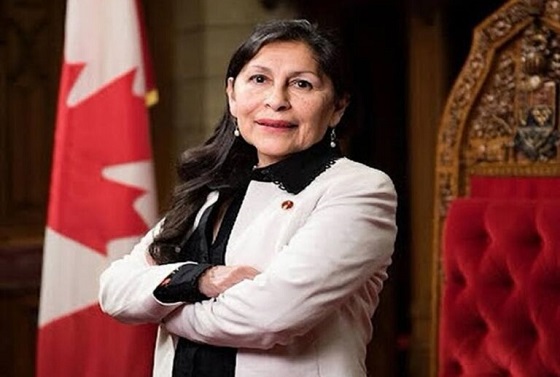Agriculture
Who Is Directing The War On Agriculture And Nutrition?

From the Frontier Centre for Public Policy
Government agencies, billionaires and pressure groups put world’s poor, hungry families last
Elite billionaire organizations and foundations, government agencies and activist pressure groups are funding and coordinating a global war on modern agriculture, nutrition, and Earth’s poorest, hungriest people. Instead of helping more families get nutritious food, better healthcare and higher living standards, they’re doing the opposite, and harming biodiversity in the process.
The World Economic Forum wants to reimagine, reinvent and transform the global food system, to eliminate greenhouse gases from food production. Central to its plan is alternatives to animal protein: meal worm potato chips, bug burgers instead of beef patties, and meat loaves and sausages made from lake flies, for instance. Fixing the WEF’s toxic workplace is apparently a low priority.
A UN Food and Agriculture Organization report advises that turning “edible insects” into “tasty” food products can create thriving local businesses and even promote “inclusion of women.”
Created to alleviate global poverty, the World Bank has decided the “manmade climate crisis” is a far greater threat to impoverished families than contaminated water, malaria and other killer diseases, hunger, or even two billion people still burning wood and dung because they don’t have reliable, affordable electricity. It has unilaterally decreed that 45% of its funds – an extra $9 billion in FY2024 – will be shifted to helping the poor “better withstand the devastation of climate change.”
Of course, most of the better and lesser-known environmental pressure groups are also deeply involved in food, agriculture and energy policy campaigns: Greenpeace, Sierra Club, EarthJustice, Friends of the Earth, Pesticide Action Network, Center for Food Safety, La Via Campesina (The Peasant Way), Alliance for Food Sovereignty in Africa, and countless others.
Like the rest of the “agro-ecology” movement, they deride and malign modern agriculture as a scourge inflicted by greedy mega-corporations. They oppose fossil fuels, pesticides, herbicides and biotechnology. They extol “food sovereignty” and the “right to choose.” But their policies reflect top-down tyranny and bullying, with little room for poor farmers to embrace modern agricultural technologies and practices.
In addition to WEF, FAO and World Bank support, these hard-green organizations have the ideological, organizational and financial backing of the US Agency for International Development, EU agencies, and a host of progressive and far-left American, European and other foundations.
The US-based AgroEcology Fund was created by the Christensen Fund, New Fields Foundation and Swift Foundation. Its funding and programs are overseen by the New Venture Fund, which helps “charitable” and “educational” organizations direct funds to programs that align with what many characterize as neo-colonialist and eco-imperialist goals.
Other major players include the Schmidt Family Foundation, Packard Foundation, Ford Foundation, Charles Stewart Mott Foundation, and Ben and Jerry Foundation.
This is serious money – hundreds of millions of dollars per year in food, agriculture and climate change funding. It completely overshadows the piddling $9,000 that Kenyan farmer Jusper Machogu raised via donations to his “climate realism” website – much of it given to neighbors, so they could drill water wells, buy tanks of propane or get connected to the local grid.
And yet Mr. Machogu incurred the wrath of the BBC’s “Climate Disinformation Officer.” (Yes, the Beeb actually has such a position.) The CDO attacked him for “tweeting false and misleading claims” about climate change and saying Africa should develop its oil, gas and coal reserves – instead of relying entirely on intermittent, weather-dependent wind and solar. Even worse, the farmer had the temerity to accept donations from non-Africans, including “individuals with links to the fossil fuel industry and groups known for promoting climate change denial.”
Rockefeller Philanthropy Advisors is another major donor to agro-ecology outfits. It’s part of the legacy of guilt-ridden oil money from John D. Rockefeller’s Standard Oil Co. corporate trust – an inheritance that includes nearly 1,000 climate-related institutions, foundations and activist organizations.
As Canada’s Frontier Centre put it,
“Every time you hear a ‘climate change’ scare story, [the person writing it] was PAID. He is a Rockefeller stooge. He may not know it, but his profession has been entirely corrupted.” Far worse, I would add, the writer and his (or her) organization are complicit in perpetuating global poverty, energy deprivation, hunger, disease and death – because the fear mongering drives destructive energy and food production policies.
Alone or collectively, these policy corrupters must not be underestimated in this war to preserve and expand modern energy, agriculture and global nutrition. Thankfully, there is increasing pushback. Many families simply do not want to be trapped in poverty, disease, mud-and-thatch huts, an absence of educational opportunities for their children, and a future of backbreaking, dawn-to-dusk labor in little subsistence-farming fields.
That’s especially so when films, news stories and cell phones present American and European farming equipment and practices – and the crop yields, wealth, health, homes, leisure time and opportunities that accompany those modern agricultural systems.
Poor farmers also see China, India, Indonesia and other countries rapidly industrializing and modernizing by using oil, gas and coal. They see rumblings of change in many countries that are intent on charting their own courses, with fossil fuels as the energy foundation for that growth. They’re rejecting the eco colonialism and eco-imperialism that wealthy Westerners seek to impose on them.
They are getting the message that humanity has faced climate fluctuations and extreme weather events throughout history … and survived them, dealt with them, adapted to them, prospered. That there is no real-world evidence that man made greenhouse gas emissions – especially the trivial amounts generated by agriculture – have replaced the powerful natural forces that caused past climate changes.
They increasingly realize that organic and subsistence farming requires vastly more land – which would otherwise be wildlife habitats – than modern mechanized farming, to get the same yields. Plowing those habitats would decimate plant and animal diversity.
That locking up fossil fuels, and relying instead on biofuels and plant-based feed stocks for thousands of essential products, would require even more acreage. So would mining for massive amounts of metals and minerals to manufacture wind, solar and battery technologies.
Most importantly, they understand that humanity today has far greater wealth, far more knowledge, far better technologies and resources than any past generations.
To suggest that we cannot adapt to climate changes, or survive and recover from extreme weather events, is simply absurd. To suggest that farmers should revert to … or remain stuck in … ancient farming practices and technologies – to save the world from computer-generated manmade climate disasters – is eco-imperialism at its most lethal.
South Africa’s electricity minister recently said his country will not be “turned into a guinea pig for a worldwide Green New Deal.” Hopefully, all developing countries will soon apply that same attitude to anarchists who would use the world’s poor as guinea pigs in global agricultural and nutrition experiments.
Paul Driessen is senior policy analyst for the Committee For A Constructive Tomorrow and author of books and articles on energy, environment, climate and human rights issues.
Agriculture
Health Canada pauses plan to sell unlabeled cloned meat

From LifeSiteNews
Health Canada has indefinitely paused its plan to allow unlabeled cloned meat in grocery stores after thousands of Canadians, prominent figures, and industry leaders condemned the move.
Health Canada is pausing its plan to put unlabeled cloned meat in Canadian grocery stores, following public outcry.
In a November 19 update on its website, Health Canada announced an indefinite suspension of the decision to remove labels from cloned meat products after thousands of Canadians condemned the plan online.
“The Government of Canada has received significant input from both consumers and industry about the implications of this potential policy update,” the publication read. “The Department has therefore indefinitely paused the policy update to provide time for further discussions and consideration,” it continued, adding, “Until the policy is updated, foods made from cloned cattle and swine will remain subject to the novel food assessment.”
In late October, Health Canada quietly approved removing labels from foods derived from somatic cell nuclear transfer (SCNT) clones and their offspring. As a result, Canadians buying meat from the grocery store would have had no way of knowing if the product was cloned meat.
Many researchers have documented high rates of cloning failure, large offspring syndrome (LOS), placental abnormalities, early death, and organ defects in cloned animals. The animals are also administered heavy doses of antibiotics due to infections and immune issues.
Typically, the offspring of cloned animals, rather than the cloned animals themselves, are processed for human consumption. As a result, researchers allege that the health defects and high drug use does not affect the final product.
However, there are no comprehensive human studies on the effects of eating cloned meat, meaning that the side-effects for humans are unknown.
News of the plan spread quickly on social media, with thousands of Canadians condemning the plan and promising to switch to local meat providers.
“By authorizing the sale of meat from cloned animals without mandatory labeling or a formal public announcement, Health Canada risks repeating a familiar and costly failure in risk communication. Deeply disappointing,” food policy expert and professor at Dalhousie University Sylvain Charlebois wrote on X.
"By authorizing the sale of meat from cloned animals without mandatory labeling or a formal public announcement, Health Canada risks repeating a familiar and costly failure in risk communication. Deeply disappointing."
More on this week's Food Professor Podcast! https://t.co/UZTIcQzUN3
— The Food Professor (@FoodProfessor) October 30, 2025
Likewise, Conservative MP Leslyn Lewis warned, “Health Canada recently decided that meat from cloned animals and their offspring no longer needs a special review or any form of disclosure.”
“That means, soon you could buy beef or pork and have no idea how it was bred,” she continued. “Other countries debate this openly: the EU has considered strict labelling, and even the U.S. has admitted that cloned-offspring meat is circulating.”
“But here in Canada, the public wasn’t even told. This is about informed choice,” Lewis declared. “If government and industry don’t have to tell us when meat comes from cloned animals, then Canadians need to ask a simple, honest question: What else are we not being told?”
Health Canada recently decided that meat from cloned animals and their offspring no longer needs a special review or any form of disclosure. That means, soon you could buy beef or pork and have no idea how it was bred.
Other countries debate this openly: the EU has considered… pic.twitter.com/zCnqJOpvf3
— Dr. Leslyn Lewis (@LeslynLewis) November 14, 2025
Likewise, duBreton, a leading North American supplier of organic pork based out of Quebec, denounced the move, saying, “Canadians expect clarity, transparency, and meaningful consultation on issues that directly touch their food supply. As producers, we consider it our responsibility and believe our governing food authorities should too.”
According to a survey conducted by duBreton, 74 percent of Canadians believe that “cloned meat and genetic editing practices have no place in farm and food systems.”
Agriculture
Federal cabinet calls for Canadian bank used primarily by white farmers to be more diverse

From LifeSiteNews
A finance department review suggested women, youth, Indigenous, LGBTQ, Black and racialized entrepreneurs are underserved by Farm Credit Canada.
The Cabinet of Prime Minister Mark Carney said in a note that a Canadian Crown bank mostly used by farmers is too “white” and not diverse enough in its lending to “traditionally underrepresented groups” such as LGBT minorities.
Farm Credit Canada Regina, in Saskatchewan, is used by thousands of farmers, yet federal cabinet overseers claim its loan portfolio needs greater diversity.
The finance department note, which aims to make amendments to the Farm Credit Canada Act, claims that agriculture is “predominantly older white men.”
Proposed changes to the Act mean the government will mandate “regular legislative reviews to ensure alignment with the needs of the agriculture and agri-food sector.”
“Farm operators are predominantly older white men and farm families tend to have higher average incomes compared to all Canadians,” the note reads.
“Traditionally underrepresented groups such as women, youth, Indigenous, LGBTQ, and Black and racialized entrepreneurs may particularly benefit from regular legislative reviews to better enable Farm Credit Canada to align its activities with their specific needs.”
The text includes no legal amendment, and the finance department did not say why it was brought forward or who asked for the changes.
Canadian census data shows that there are only 590,710 farmers and their families, a number that keeps going down. The average farmer is a 55-year-old male and predominantly Christian, either Catholic or from the United Church.
Data shows that 6.9 percent of farmers are immigrants, with about 3.7 percent being “from racialized groups.”
National census data from 2021 indicates that about four percent of Canadians say they are LGBT; however, those who are farmers is not stated.
Historically, most farmers in Canada are multi-generational descendants of Christian/Catholic Europeans who came to Canada in the mid to late 1800s, mainly from the United Kingdom, Ireland, Ukraine, Russia, Italy, Poland, the Netherlands, Germany, and France.
-

 Alberta2 hours ago
Alberta2 hours agoFrom Underdog to Top Broodmare
-

 Crime2 days ago
Crime2 days agoB.C.’s First Money-Laundering Sentence in a Decade Exposes Gaps in Global Hub for Chinese Drug Cash
-

 Agriculture2 days ago
Agriculture2 days agoHealth Canada pauses plan to sell unlabeled cloned meat
-

 Crime2 days ago
Crime2 days agoFBI Seizes $13-Million Mercedes Unicorn From Ryan Wedding’s Narco Network
-

 armed forces2 days ago
armed forces2 days ago2025 Federal Budget: Veterans Are Bleeding for This Budget
-

 International2 days ago
International2 days agoAmerica first at the national parks: Trump hits Canadians and other foreign visitors with $100 fee
-

 Banks2 days ago
Banks2 days agoThe Bill Designed to Kill Canada’s Fossil Fuel Sector
-

 Alberta1 day ago
Alberta1 day agoAlberta and Ottawa ink landmark energy agreement






